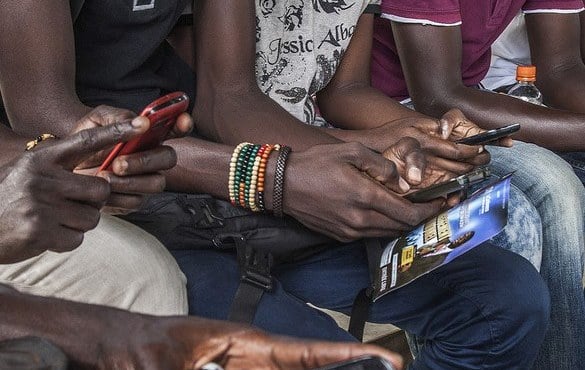Last week saw two of the biggest annual data surveys hit the headlines: Mary Meeker’s State of the Internet, and Ericsson’s Mobility Report.
You’ll find the key findings and links to these studies here – plus all the other interesting data-related news in this week’s MEF market stats round up…

Advertisers are under-spending on mobile by $22 billion a year
People spend 25 per cent of their time on mobile, but advertisers only spend 12 per cent of the budgets on mobile ads.
That’s one of hundreds of data points in KPCG’s Mary Meeker’s legendary annual ‘state of the internet’ presentation. She says the mobile ad market is worth about $22 billion in the US, against $39 billion on the fixed internet. Yet the latter has three per cent less attention from consumers. She concludes that brands should be spending $22 billion more on mobile.
As usual, the report is as treasure trove of insights and revealing data nuggets. Check it our here.
More IoT devices than phones by 2018
The number of IoT connected devices is expected to grow by 23 per cent a year between 2015 and 2021, says the latest edition of the Ericsson Mobility Report.
This growth will make the installed base of IoT devices bigger than phones inside two years. Of the 28 billion devices that will be connected by 2021, close to 16 billion will be IoT devices.
Western Europe will lead the way, with IoT devices set to grow 400 per cent by 2021. The market will be accelerated by the launch of 5G, which makes uses ‘network slicing’ to make it possible to connect exponentially more devices than is possible today.
The annual Ericsson Mobility Report is overflowing with data. Other highlights include:
- By 2021, smartphone subscriptions will almost double from 3.4 billion to 6.3 billion.
- There are 5 billion mobile subscribers in the world today
- Use of cellular data for smartphone video grew 127 per cent in 15 months (2014-15)
- Global mobile data traffic grew 60 per cent between Q1 2015 and Q1 2016,
- LTE subscriptions stand at 1.2 billion worldwide
Operators can generate $13 billion from wearables data traffic
Consumers will buy 240 million wearable devices within four years to create a market worth $40 billion, says new research from ReportsnReports.
This activity will help mobile operators drive over $13 billion in service revenue by the end of 2020. The two top smartphone OEMs, Apple and Samsung, will share 75 per cent of the market.
The report asserts that wearables will impact an array of verticals including: consumer, healthcare, sports, retail, gospitality, military and government.
100 million Bangladeshi mobile phone SIMs have been registered with biometric details
Bagladesh’s State Minister for Telecom Tarana Halim has revealed that 75 per cent of the country’s SIMs – 100.9 million – are now linked to fingerprints.
She made the announcement after the government ordered mandatory biometric registration for all 130 million mobile users in April.
The move was designed to limit fraud and identity theft. But it faced some criticism from privacy campaigners and the deadline for registering and re-registering was moved a number of times. But now SIM cards are not being sold without buyers’ fingerprints any more.
Minecraft sales pass 100 million across all platforms
The Minecraft phenomenon shows no sign of slowing down. A report in Engadget says 53,000 copies of the game are sold every day. It has 40 million regular players.
This is great news for Microsoft, which bought Minecraft developer Mojang two years ago. Fans worried Microsoft would change it, while analysts wondered if this association with a big corporate would deter fans.
Neither happened. Though Microsoft launched a Hololens version and a spin-off adventure series by Telltale Games, the basic concept was untouched. Players can still build anything they imagine, using simple blocks.
People spend 24 per cent more on in-app than upfront app payments
When it comes to the app economy, freemium is winning. That’s the headline conclusion of new research by Gartner, which says mobile app users spend 24 per cent more on in-app transactions than on upfront app payments.
It revealed users are spending $7.40 on paid-for apps every three months and $9.20 on in-app transactions. The survey found that younger people are more confident with in-app transactions than their elders. Among users who have changed spending levels on mobile apps in the last year, 62 per cent have increased their in-app transactions, versus 55 percent for paid-for downloads.
420 million phone users have installed ad blockers
The number of people loading ad blockers to their phones went up 90 per cent in the last year, according to a new report by Pagefair. That brings the total to 420 million.
The data reveals that ad blockers are especially popular in China, India, and Pakistan. Thirty-six percent of smartphone owners in the Asia-Pacific region now block ads on the mobile web.
They are less popular in Europe and North America. Indeed, in the US, the number is 4.3 million – just two per cent of the smartphone owning population.
The report suggests that the reason ad blockers are so popular in developing nations is that they reduce load times and bandwidth use.
It all adds to the debate surrounding this controversial topic. In a previous report, PageFair estimated that ad blocking cost publishers $21.8 billion in 2015.
One in four users use an app only once
Another report has revealed what we already know: most people only ever use a very small number of apps. Most apps are never used.
Data from analytics firm Localytics says 62 per cent of users will use an app less than 11 times. It adds that 23 per cent will launch an app only once. In 2014, only 20 per cent of users were abandoning apps.
However, the firm is optimistic in some regards. It says advancements made to the overall app experience on iOS devices – multitasking, split screen, allowing notifications to be presented in chronological order – could improve the way consumers engage with their favourite apps.
It also found that apps in the mid-stage of growth, between 15,000 and 50,000 MAUs, had the strongest year over year lift when it came to user abandonment and retention.
Snapchat is bigger than Twitter
Auto-delete messaging app Snapchat now has 150 million daily users; Twitter has 140 million.
That’s the landmark headline of a report in Bloomberg, which reflect the upwards curve of Snapchat and the ongoing struggles of Twitter. It says Snapchat has aded 40 million daily users since December.
Twitter is generally acknowledged to have a problem scaling its user base beyond a certain point. It has 310 million monthly active users, according to its most recent earnings report, and an implied daily active user count of 136 million. Recently, its CEO Jack Dorsey revealed plans to simplify the service to make it easier for new users to join.
Meanwhile Snapchat has added popular new features such as overlays and the option to post a daily story. It also offers channels to brands.













